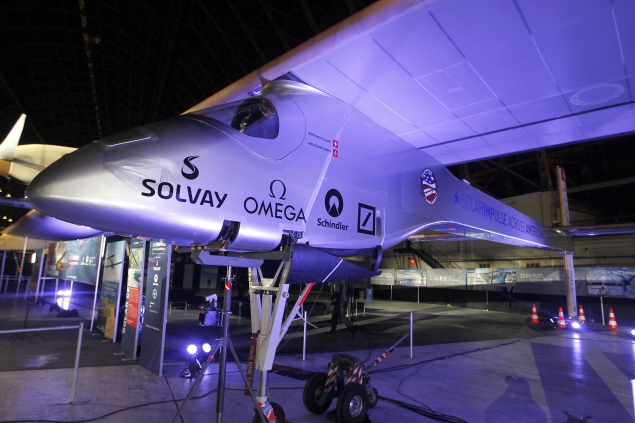- Home
- Others
- Others News
- Solar powered plane set for first cross country flight from California
Solar-powered plane set for first cross-country flight from California

Departure was set for 6 a.m. local time from Moffett Field, a joint civil-military airport near the south end of San Francisco, with the spindly looking plane, dubbed the Solar Impulse, headed first to Phoenix on a slow-speed flight expected to take 19 hours.
(Also see: Sun-powered plane completes California test flight)
After additional stops in Dallas, St. Louis and Washington, D.C., with pauses at each destination to wait for favorable weather, the flight team hopes to conclude the plane's cross-country voyage in about two months at John F. Kennedy International Airport in New York.
Swiss pilots and co-founders of the project, Bertrand Piccard and Andre Borschberg, will take turns flying the plane, built with a single-seat cockpit, with Piccard slated to be at the controls for the first flight to Arizona. He is scheduled to land in Phoenix at 1 a.m. local time on Saturday.
The project began in 2003 with a 10-year budget of 90 million euros and has involved engineers from Swiss escalator maker Schindler and research aid from Belgian chemicals group Solvay backers who want to test new materials and technologies while also gaining brand recognition.
Project organizers say the journey is also intended to boost worldwide support for the adoption of clean-energy technologies.
With the wingspan of a jumbo jet and weighing the same as a small car, the Solar Impulse is a test model for a more advanced aircraft the team plans to build to circumnavigate the globe in 2015.
The plane made its first intercontinental flight, from Spain to Morocco, last June.
Solar cells built into wings
The aircraft runs on about the same power as a motor scooter, propelled by energy collected from 12,000 solar cells built into the wings that simultaneously recharge batteries with a storage capacity equivalent to a Tesla electric car.
In that way, the Solar Impulse can fly after dark on solar energy generated during daylight hours, and will become the first solar-powered aircraft capable of operating day and night without fuel to attempt a U.S. coast-to-coast flight.
But the plane is unlikely to set any speed or altitude records. It can climb gradually to 28,000 feet (8,500 meters) and flies at an average pace of just 43 miles per hour (69 km per hour).
The current plane was designed for flights of up to 24 hours at a time, but the next model will have to allow for up to five days and five nights of flying by one pilot - a feat never yet accomplished.
Meditation and hypnosis were part of the training for the pilots as they prepared to fly on very little sleep.
Asked about the downside of solar-powered flight at a news conference in March to unveil the current plane, Piccard acknowledged there was a price paid for the tiny carrying capacity and massive wings.
"In that sense, it is not the easiest way to fly," he said. "But it is the most fabulous way to fly, because the more you fly, the more energy you have on board."
He added: "We want to inspire as many people as possible to have that same spirit: to dare, to innovate, to invent."
The plane's four large batteries, attached to the bottom of the wings along with the plane's tiny motors, account for a quarter of its overall heft.
The aircraft's lightweight carbon fiber design and wingspan allow it to conserve energy, but also make the plane vulnerable to being tipped over.
A ground team of weather specialists, air traffic controllers and engineers track the plane's speed and battery levels and help the pilot steer clear of turbulence. Solar Impulse cannot fly in strong wind, fog, rain or clouds. Its machinery is not even designed to withstand moisture.
© Thomson Reuters 2013
Get your daily dose of tech news, reviews, and insights, in under 80 characters on Gadgets 360 Turbo. Connect with fellow tech lovers on our Forum. Follow us on X, Facebook, WhatsApp, Threads and Google News for instant updates. Catch all the action on our YouTube channel.
Related Stories
- Samsung Galaxy Unpacked 2025
- ChatGPT
- Redmi Note 14 Pro+
- iPhone 16
- Apple Vision Pro
- Oneplus 12
- OnePlus Nord CE 3 Lite 5G
- iPhone 13
- Xiaomi 14 Pro
- Oppo Find N3
- Tecno Spark Go (2023)
- Realme V30
- Best Phones Under 25000
- Samsung Galaxy S24 Series
- Cryptocurrency
- iQoo 12
- Samsung Galaxy S24 Ultra
- Giottus
- Samsung Galaxy Z Flip 5
- Apple 'Scary Fast'
- Housefull 5
- GoPro Hero 12 Black Review
- Invincible Season 2
- JioGlass
- HD Ready TV
- Laptop Under 50000
- Smartwatch Under 10000
- Latest Mobile Phones
- Compare Phones
- OnePlus 15R
- Realme Narzo 90x 5G
- Realme Narzo 90 5G
- Vivo S50 Pro Mini
- Vivo S50
- OPPO Reno 15c
- Redmi Note 15 5G
- Redmi Note 15 Pro 5G
- Asus ProArt P16
- MacBook Pro 14-inch (M5, 2025)
- Infinix Xpad Edge
- OnePlus Pad Go 2
- OnePlus Watch Lite
- Just Corseca Skywatch Pro
- Acerpure Nitro Z Series 100-inch QLED TV
- Samsung 43 Inch LED Ultra HD (4K) Smart TV (UA43UE81AFULXL)
- Asus ROG Ally
- Nintendo Switch Lite
- Haier 1.6 Ton 5 Star Inverter Split AC (HSU19G-MZAID5BN-INV)
- Haier 1.6 Ton 5 Star Inverter Split AC (HSU19G-MZAIM5BN-INV)

















